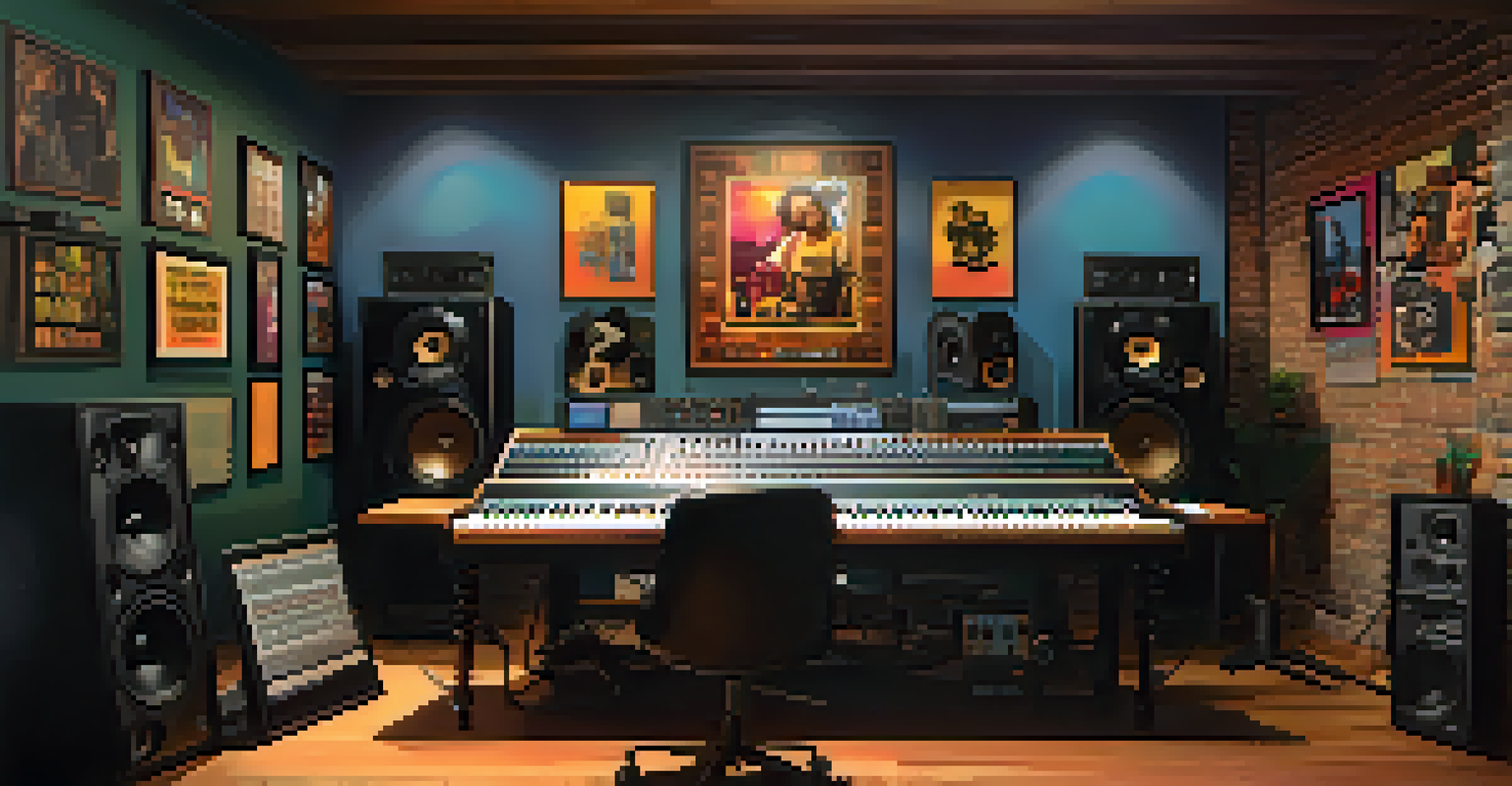The Intersection of Hip-Hop and Global Music Cultures

Understanding Hip-Hop: A Cultural Phenomenon
Hip-hop began in the streets of the Bronx in the 1970s, rooted in African American and Latino cultures. It quickly evolved from a local movement to a global phenomenon, encompassing not just music, but also art, dance, and fashion. This multifaceted culture reflects the struggles and triumphs of marginalized communities, making it a powerful voice for social change.
Hip-hop is a voice for the voiceless, a means to speak out against injustices and express the struggles of marginalized communities.
What sets hip-hop apart is its ability to adapt and resonate with diverse audiences worldwide. Whether through the beat of a drum or the rhythm of spoken word, hip-hop speaks a universal language of resilience and creativity. This adaptability has allowed it to merge seamlessly with various music styles, from reggae to electronic dance music.
As hip-hop continues to grow, it invites global artists to interpret its essence in their own unique ways, fostering a rich tapestry of sounds that reflect different cultural narratives. This intersection not only enhances the genre but also enriches the local music scenes, creating a vibrant dialogue among musicians from various backgrounds.
Hip-Hop's Global Reach: A Cultural Exchange
The globalization of hip-hop has enabled artists to collaborate across continents, creating a fusion of styles that transcends borders. For instance, collaborations between American hip-hop artists and African musicians have resulted in groundbreaking sounds that blend traditional rhythms with modern beats. This exchange cultivates a greater appreciation for diverse musical traditions.

Take the example of South African hip-hop, which incorporates local languages and influences, creating a distinct sound that resonates with its audience. Artists like Nasty C and Cassper Nyovest are redefining what hip-hop can sound like, proving that the genre is not confined to its American roots. Their work showcases how hip-hop can be a canvas for cultural expression.
Hip-Hop's Global Evolution
Hip-hop has transformed from a local Bronx movement into a worldwide cultural phenomenon, blending diverse musical styles and narratives.
These collaborations not only elevate the artists involved but also introduce fans to new genres and cultural experiences. As listeners engage with these blended sounds, they become part of a larger conversation about identity, heritage, and the power of music to unite people from all walks of life.
Local Flavors: Hip-Hop and Regional Influences
As hip-hop spreads globally, it absorbs local influences that give rise to new sub-genres. In Latin America, for example, reggaeton has emerged, heavily influenced by hip-hop, creating a vibrant sound that dominates the charts. Artists like Bad Bunny and J Balvin exemplify this blend, showcasing their cultural roots while embracing hip-hop's rhythmic style.
The beauty of hip-hop is its ability to transcend borders and connect people from different cultures through a shared love of music.
In Asia, hip-hop has taken on diverse forms, from the catchy hooks of K-pop to the gritty sounds of Chinese rap. Groups like BTS incorporate hip-hop elements to appeal to a global audience while maintaining their cultural identity. This dynamic interplay allows for innovative musical expressions that keep evolving.
These local adaptations of hip-hop highlight the genre's versatility and its ability to connect with audiences in deeply personal ways. By incorporating local languages, instruments, and themes, artists create music that resonates with their communities while still participating in the global hip-hop conversation.
The Role of Technology in Hip-Hop's Evolution
Technology has played a crucial role in the evolution of hip-hop, allowing artists to share their music worldwide. The rise of social media platforms and streaming services has democratized music distribution, enabling even unsigned artists to reach global audiences. This accessibility has led to a surge of creativity and experimentation within the genre.
Platforms like SoundCloud and TikTok have become launchpads for emerging talent, where new sounds can go viral overnight. This rapid dissemination of music means that hip-hop is constantly evolving, influenced not only by traditional sounds but also by contemporary trends and digital culture. Artists can quickly test new ideas and receive instant feedback from fans.
Social Justice Through Music
Artists use hip-hop as a powerful platform to address social issues, inspiring activism and conversations around inequality and injustice.
Moreover, technology facilitates collaboration across geographical boundaries, creating a melting pot of ideas and styles. As artists from different backgrounds come together, they create innovative tracks that reflect a modern globalized society, proving that hip-hop is not just a genre, but a living, breathing art form.
Hip-Hop as a Voice for Social Justice
One of hip-hop's most powerful aspects is its role as a vehicle for social commentary. Artists often use their platforms to address issues like inequality, racism, and police brutality, sparking conversations that resonate with audiences worldwide. This activism has made hip-hop a crucial part of modern social movements.
Take Kendrick Lamar’s “Alright,” which became an anthem for the Black Lives Matter movement. His lyrics not only reflect personal experiences but also amplify the struggles faced by marginalized communities. This ability to connect on such a profound level is what makes hip-hop an essential tool for advocacy and change.
As hip-hop continues to evolve, its artists remain committed to using their voices for social justice. By speaking out about systemic issues, they inspire a new generation of activists who see music as a powerful force for change. This intersection of hip-hop and activism creates a legacy that extends far beyond the music itself.
Cultural Appropriation vs. Appreciation in Hip-Hop
As hip-hop gains global influence, it raises important discussions about cultural appropriation versus appreciation. Some argue that when artists from outside hip-hop's origins adopt its elements without understanding their significance, it can dilute the culture. It's crucial to navigate this landscape thoughtfully to respect the roots of the genre while exploring its global appeal.
For instance, when mainstream artists incorporate hip-hop influences, they must acknowledge and honor its origins. Collaborations that celebrate hip-hop's history, like those between Western artists and traditional musicians, can foster appreciation rather than appropriation. This creates a more inclusive and respectful dialogue within the music community.
Navigating Cultural Appreciation
As hip-hop expands globally, it raises important discussions about cultural appropriation versus appreciation, emphasizing the need to honor its roots.
Ultimately, the goal should be to uplift and empower the original voices while allowing for creative exploration. By fostering genuine connections and understanding, hip-hop can continue to thrive as a global movement that celebrates diverse cultural expressions.
The Future of Hip-Hop in a Globalized World
As hip-hop continues to intersect with global music cultures, its future is as exciting as it is unpredictable. With advancements in technology and the rise of new platforms, we can expect even more innovative sounds and collaborations. This evolution will likely give birth to entirely new sub-genres that reflect the complexities of our interconnected world.
Moreover, as societal issues grow and change, hip-hop will continue to serve as a mirror, reflecting the hopes and struggles of diverse communities. The genre's commitment to storytelling ensures that it remains relevant, offering insights into the human experience across different cultures and backgrounds.

In this dynamic landscape, hip-hop's role as a cultural ambassador will remain vital. By fostering connections across borders, hip-hop not only entertains but also educates, encourages dialogue, and promotes unity among its listeners, paving the way for a more inclusive future in music.